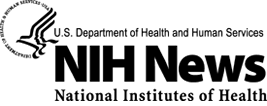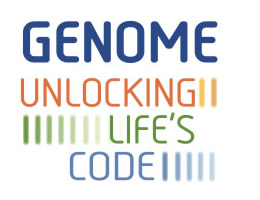Last updated: June 13, 2013
2013 News Release New Exhibition Makes Genome Accessible To The Public

National Human Genome Research Institute
New exhibition makes genome accessible to public
Unique NIH-Smithsonian collaboration unlocks the present and future of genome science
 Bethesda, Md., Thurs., June 13, 2013 - The Smithsonian Institution's first state-of-the-art exhibition about genome science, Genome: Unlocking Life's Code, opens Friday, June 14, 2013, at the National Museum of Natural History in partnership with the National Human Genome Research Institute (NHGRI), a part of the National Institutes of Health (NIH).
Bethesda, Md., Thurs., June 13, 2013 - The Smithsonian Institution's first state-of-the-art exhibition about genome science, Genome: Unlocking Life's Code, opens Friday, June 14, 2013, at the National Museum of Natural History in partnership with the National Human Genome Research Institute (NHGRI), a part of the National Institutes of Health (NIH).The exhibition examines the complexities of the genome - the complete set of genetic or hereditary material of a living organism - and chronicles the remarkable breakthroughs that have taken place since the completion of the Human Genome Project a decade ago. With cutting-edge interactives, 3D models, custom animations and engaging videos of real-life stories, the exhibition examines both the benefits and the challenges that genomics presents to modern society.
"This exhibition reflects a remarkably productive collaboration between components of two scientific icons of the U.S. government - the Smithsonian Institution and the National Institutes of Health," said Eric D. Green, M.D., Ph.D., director of NHGRI, one of the 27 institutes and centers that make up NIH. "Our ability to showcase the science of genomics to the roughly 7 million annual visitors of the National Museum of Natural History is profoundly exciting for the broader genomics research community."
The exhibition's opening celebrates the anniversaries of two landmark scientific discoveries: the 10th anniversary of the Human Genome Project's completion and the 60th anniversary of Drs. James Watson's and Francis Crick's discovery of DNA's double-helical structure. It will be open at the National Museum of Natural History until September 1, 2014, after which the exhibition will travel throughout North America for four years.
"Genomic research is a vital tool for exploring the mysteries of the natural world and it is an important part of Smithsonian science," said Kirk Johnson, the Sant Director of the National Museum of Natural History. "Genome: Unlocking Life's Code will help our visitors understand how genomics is transforming what we know about ourselves and how we make important life decisions."
From the moment visitors enter the approximately 2,900 square-foot exhibition, they will find themselves immersed in an interactive, futuristic environment that communicates the revolutionary nature of genomics. The exhibition gives visitors a window into genomes that provides new ways of looking at themselves as individuals, as members of a family and a species, and as part of the diversity of life on Earth.
Genome: Unlocking Life's Code is organized around three content areas offering visitors personalized and interactive experiences that explore what a genome is (The Genome Within Us), how it relates to medicine and health (Your Genome, Your Health), and how it connects humans to all of life on the planet (Connections: Natural World and Genomic Journey). Within each gallery, numerous topics are explored through the latest imagery on genomics, hands-on and media interactives, videos and other engaging content. Through examples of ways that genome science can affect their lives in ordinary and extraordinary ways, visitors will also come to learn how genomics can affect perspectives about health, identity and the place of humans in the natural world.
Genome: Unlocking Life's Code will take visitors on a genomic journey from the present to the future:
The Genome Within Us: Upon arrival, museum-goers will be oriented at the center of the exhibition where they will explore how the genome is a part of their own bodies. Visitors will discover what a genome is, where it is located in the human body (in the cell nucleus), and how it works to regulate life, through introductory videos produced by the History® channel. Visitors will see three-dimensional models of a human genome and watch interviews with Human Genome Project researchers. Visitors can also participate in a social media interactive where they can explore the ethical, legal, and social implications of advancing DNA sequencing technologies, submit their responses on an interactive station and find out how their views compare with those of other visitors. An electronic news ticker display will provide an ongoing stream of recent developments in genomics.
Your Genome, Your Health: Guests can explore the many ways in which genome sequencing benefits patients through improved health care. They can learn about genes, genomic solutions to mysterious medical diseases, and, through a futuristic DNA interactive, search for the right medicine for a given disease. An interactive puzzle allows visitors to learn how genetic, environmental and random factors influence risk for a particular disease.
Connections: Natural World and Genomic Journey: Visitors will learn about the ways that genomes reflect the connection of all life on the planet, human ancestry and evolution - and even human society. There will be an opportunity to learn more about how the Smithsonian is using new genomic technologies to preserve genetic diversity and study changes in our environment through the Global Genome Initiative (GGI) and GGI's growing biorepository.
"Today, the Smithsonian is a leader in utilizing genomic research to understand the diversity of life on earth," said Jonathan Coddington, Ph.D., associate director for science at the National Museum of Natural History. "This exhibition provides a unique opportunity to showcase the cutting edge, biotechnological research going on behind-the-scenes at the museum, and features some of our scientists' work on hot topics like bird strikes, butterflies, wine grapes, bio-coding, Tasmanian devils and the Global Genome Initiative. Thanks to genomics, we now have the tools to sequence every organism on the planet, allowing us to preserve genetic diversity, study changes in our environment and learn more about how these changes affect all life on earth."
In addition to the exhibition, a special educational website, Genome: Unlocking Life's Code (unlockinglifescode.org), was created to support the exhibition and provide additional educational materials beyond the walls of the museum. A program of ongoing educational events in Washington, D.C., is also being developed and will be announced on the website.
"Collaborating with the Smithsonian National Museum of Natural History in the development of the genome exhibition created an opportunity to educate the public about advances in genomics research," said Vence L. Bonham, Jr., J.D., chief of the education branch in NHGRI's Division of Policy, Communications and Education. "NHGRI engages communities across the country to explore genomics and health, but this is the first collaboration with the Smithsonian Institution, which will reach millions of visitors at the National Museum of Natural History."
The exhibition was made possible through the generous support of the Life Technologies Foundation, and other important sponsors, including Johnson & Johnson, Ancestry.com and The Brin Wojcicki Foundation.
Additional information for media is available at www.genome.gov/27554010/nhgri-smithsonian-exhibition-press-briefing-resources/. For images of Genome: Unlocking Life's Code and other related photos, please visit newsdesk.si.edu/photos.
NHGRI is one of the 27 institutes and centers at the National Institutes of Health, which is an agency of the U.S. Department of Health and Human Services. NHGRI conducts genomics research in its own labs in Maryland, as well supports genomics research at institutions across the country. Additional information about NHGRI can be found at www.genome.gov.
About the National Institutes of Health (NIH): NIH, the nation's medical research agency, includes 27 institutes and centers and is a component of the U.S. Department of Health and Human Services. NIH is the primary federal agency conducting and supporting basic, clinical, and translational medical research, and is investigating the causes, treatments, and cures for both common and rare diseases. For more information about NIH and its programs, visit www.nih.gov.
The Smithsonian's National Museum of Natural History, located at 10th Street and Constitution Avenue N.W., Washington, D.C., is the world's most visited natural history museum and is open every day from 10 a.m. to 5:30 p.m. with extended evening hours in the summer. It also houses the world's largest collection of natural history specimens, which are managed by a research staff of more than 100 Ph.D.-level scientists. Learn more at www.mnh.si.edu or on the museum's social media platforms.
Contact:
Omar McCrimmon
301-402-0911
mccrimmono@mail.nih.gov Posted: June 13, 2013
